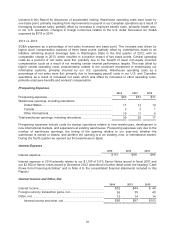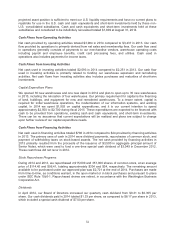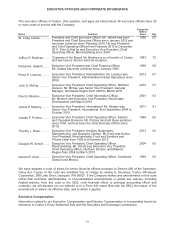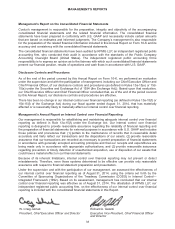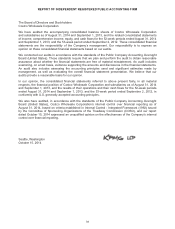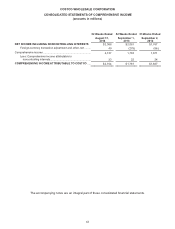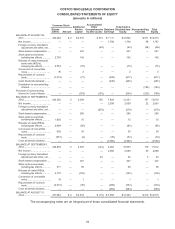Costco 2014 Annual Report Download - page 38
Download and view the complete annual report
Please find page 38 of the 2014 Costco annual report below. You can navigate through the pages in the report by either clicking on the pages listed below, or by using the keyword search tool below to find specific information within the annual report.market funds. Our wholly-owned captive insurance subsidiary invests in U.S. government and
government agency obligations, corporate notes and bonds, and asset and mortgage-backed securities
with a minimum overall portfolio average credit rating of AA+.
Our Canadian and other international subsidiaries’ investments are primarily in money market funds,
bankers’ acceptances and bank certificates of deposit, generally denominated in their local currencies.
We performed a sensitivity analysis to determine the impact that a 100 basis-point change in interest
rates would have on the value of our investment portfolio. At the end of 2014, the incremental change in
the fair market value was immaterial. For those investments that are classified as available-for-sale, the
unrealized gains or losses related to fluctuations in market volatility and interest rates are reflected within
stockholders’ equity in accumulated other comprehensive income.
The nature and amount of our long-term debt may vary as a result of future business requirements,
market conditions, and other factors. As of the end of 2014, the majority of our long-term debt is fixed rate
Senior Notes, carried at $4,596. Fluctuations in interest rates may affect the fair value of the fixed-rate
debt. See Note 4 to the consolidated financial statements included in this Report for more information on
our long-term debt.
Foreign Currency-Exchange Risk
Our foreign subsidiaries conduct certain transactions in their non-functional currencies, which exposes us
to fluctuations in exchange rates. We manage these fluctuations, in part, through the use of forward
foreign-exchange contracts, seeking to economically hedge the impact of fluctuations of foreign exchange
on known future expenditures denominated in a non-functional foreign-currency. The contracts are
intended primarily to economically hedge exposure to U.S. dollar merchandise inventory expenditures
made by our international subsidiaries whose functional currency is other than the U.S. dollar. Currently,
these contracts do not qualify for derivative hedge accounting. We seek to mitigate risk with the use of
these contracts and do not intend to engage in speculative transactions. These contracts do not contain
any credit-risk-related contingent features.
While we seek to manage counterparty risk associated with these contracts by limiting transactions to
counterparties with which we have established banking relationships, there can be no assurance that this
practice is effective. These contracts are limited to less than one year in duration. See Note 1 and Note 3
to the consolidated financial statements included in Item 8 of this Report for additional information on the
fair value of unsettled forward foreign-exchange contracts at the end of 2014 and 2013. A hypothetical
10% strengthening of the functional currency compared to the non-functional currency exchange rates at
August 31, 2014 would have decreased the fair value of the contracts by $56 and resulted in an
unrealized loss in the consolidated statements of income for the same amount.
Commodity Price Risk
We are exposed to fluctuations in prices for energy that we consume, particularly electricity and natural
gas, which we seek to partially mitigate through fixed-price contracts for certain of our warehouses and
other facilities, predominately in the U.S. and Canada. We also enter into variable-priced contracts for
some purchases of electricity and natural gas, in addition to fuel for our gas stations, on an index basis.
These contracts meet the characteristics of derivative instruments, but generally qualify for the “normal
purchases or normal sales” exception under authoritative guidance and, thus, require no mark-to-market
adjustment.
36






